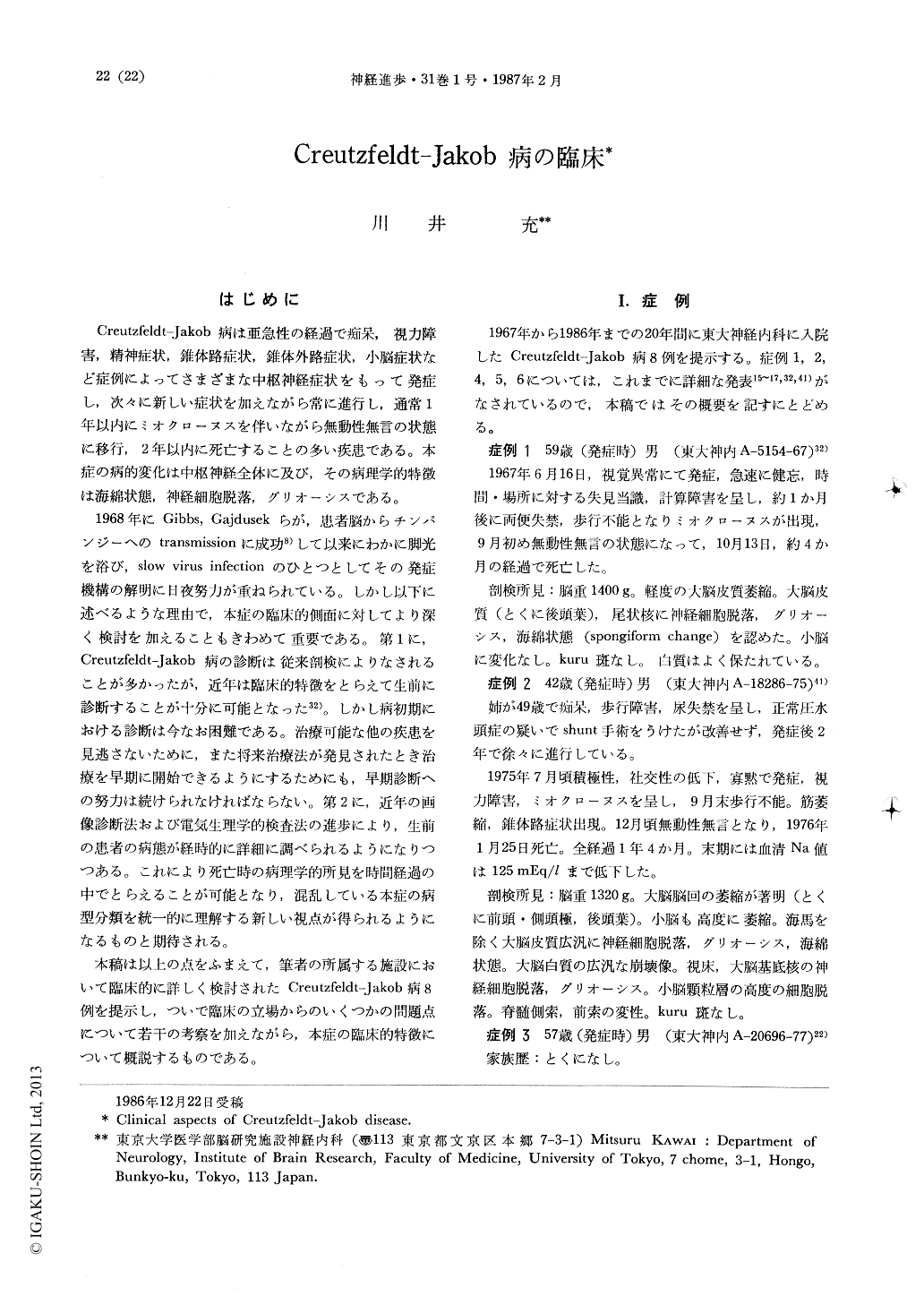Japanese
English
- 有料閲覧
- Abstract 文献概要
- 1ページ目 Look Inside
はじめに
Creutzfeldt-Jakob病は亜急性の経過で痴呆,視力障害,精神症状,錐体路症状,錐体外路症状,小脳症状など症例によってさまざまな中枢神経症状をもって発症し,次々に新しい症状を加えながら常に進行し,通常1年以内にミオクローヌスを伴いながら無動性無言の状態に移行,2年以内に死亡することの多い疾患である。本症の病的変化は中枢神経全体に及び,その病理学的特徴は海綿状態,神経細胞脱落,グリオーシスである。
1968年にGibbs,Gajdusekらが,患者脳からチンパンジーへのtransmissionに成功8)して以来にわかに脚光を浴び,slow virus infectionのひとつとしてその発症機構の解明に日夜努力が重ねられている。しかし以下に述べるような理由で,本症の臨床的側面に対してより深く検討を加えることもきわめて重要である。第1に,Creutzfeldt-Jakob病の診断は従来剖検によりなされることが多かったが,近年は臨床的特徴をとらえて生前に診断することが十分に可能となった32)。しかし病初期における診断は今なお困難である。治療可能な他の疾患を見逃さないために,また将来治療法が発見されたとき治療を早期に開始できるようにするためにも,早期診断への努力は続けられなければならない。第2に,近年の画像診断法および電気生理学的検査法の進歩により,生前の患者の病態が経時的に詳細に調べられるようになりつつある。
8 patients of Creutzfeldt-Jakob disease were admitted to Tokyo University Hospital from 1967 to 1986 and 7 cases were autopsied. None of these cases showed kuru plaques. The total duration of the illness was 20.0±17.3 months in these patients and 14.2±15.9 months in the 62 autopsied cases withot kuru plaques reported in the lieteratures from Japan. These figures are evidently much longer than those reported from the western countries. According to the criteria proposed by Bernoulli et al. (1979), the course of the illness was divided into 3 stages: Stage 1; There is a subjective awareness of physical or mental disorder, with or without minor sensorimotor or behavioral sings, insufficient to impair the patient's normal daily activities. Stage 2; There are unequivocal signs of neurologic disease, usually sufficient to impair the patient's daily activities. Stage 3; There is an incapacitating dementia, usually with severe myoclonus. Presumably because identification between the stage 1 and the stage 2 is often difficult, especially in the cases reported in the lieteratures. Masters et al. (1978) and Galvez et al. (1980) divided the course of the illness into 2 stages: The prodromal stage which corresponds to the stage 1 and the stage 2 as a whole and the dementing/myoclonic stage which corresponds to the stage 3 of Bernoulli. The duration of stage 1, stage 2, stage 3 was 1.5±1.2 months, 2.5±1.2 months, 16.0±16.5 months in the presented 8 cases and 9±10 weeks, 10±13 weeks, 14±17 weeks according to Bernoulli (1979) respectively. The duration of the prodromal stage and the dementing/myoclonic stage was 5.3 ±6.4 months and 8.9±13.2 months in autopsied cases in Japan, 3.5±3.9 months and 3.9±4.6 months according to Masters et al. (1978) and 2.2±2.1 month and 4.8±6.8 months according to Galvez et al. (1980) respectively. There was no correlation between the duration of the stage 1 and the stage 2 as a whole and that of the stage 3. As the clinical features of each stage of the Japanese patients were identical with those from western countries. The long clinical course in Japanese patients could be attributed not to the different types of the disease, but to the relatively more intensive care of the apallic patients of stage 3 in Japan.

Copyright © 1987, Igaku-Shoin Ltd. All rights reserved.


